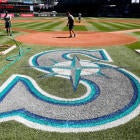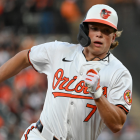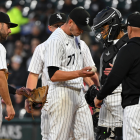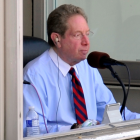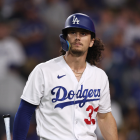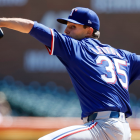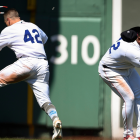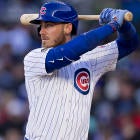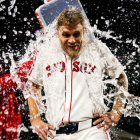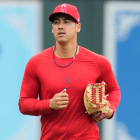With the regular season concluding, we've decided to take a look at each team's future -- not by using a crystal ball or other psychic abilities, but by evaluating their farm systems. Below you'll find our ranking of the top five prospects in the organization -- sorted by perceived future potential -- as well as five other players who fit various categories. Those categories are:
2020 contributor: A player who is likely to play a role for the big-league team next season.
Analyst's pick: A player who is a strong statistical performer and/or whose underlying measures are better than the scouting reports suggest.
Riser: A player on the way up.
Faller: A player on the way down.
One to watch: An interesting player to keep in mind (for whatever reason).
These rankings were compiled after talking with various industry sources about the systems (and players) in question. It should be acknowledged that this process is more art than science, and that there are limits to ordinal rankings. Still, it's an intuitive system, and our hope is that the write-ups will answer any questions by providing additional context and analysis of each player -- such as their pluses and minuses; the risk factors involved; and their estimated arrival date.
One last word on eligibility: we're following MLB's rookie guidelines by disqualifying any player with more than 130 big-league at-bats or 50 innings pitched.
The Seattle Mariners have the longest postseason drought in baseball, and have traded many of their most desirable big-league players over the last 12 months. They should have a good farm system -- and they do, led by a pair of talented outfielders.
1. Jarred Kelenic, OF
The gem of the Robinson Cano trade, Jarred Kelenic asserted himself as the top prospect in Seattle's system with an impressive age-19 season that saw him hit .291/.364/.540 with 23 homers and 20 steals across three levels -- including 21 Double-A contests. Perhaps unsurprisingly, Kelenic is expected to be an above-average hitter at the big-league level.
Kelenic is more than just a stick though. He can run, and for the time being he's likely to remain in center thanks to his footspeed and his big-time arm. There's a chance he has to move to a corner (likely right) down the road, but there's star potential if he can stick up the middle.
Kelenic won't be able to legally drink until July. By then, he could be knocking on the big-league door. Whether Seattle chooses to answer it before the 2021 season rolls around is to be seen.
2. Julio Rodriguez, OF
Julio Rodriguez won't turn 19 until the end of the year, but he's already established himself as one of the better outfield prospects in the minors.
Rodriguez is listed at 6-foot-4, 225 pounds and looks the part. Although he was more than three years younger than the average bear in both leagues he played in during the 2019 season, he still hit .326/.390/.540 with 12 home runs. Should Rodriguez develop as expected, he's likely to bat in the middle of an order someday while providing both average and big-time pop.
Defensively, Rodriguez isn't quite as impressive. He has a strong arm and should end up in right field, but let's be real: few are going to care about that so long as he hits like he can.
3. Logan Gilbert, RHP
Originally the 14th pick in the 2018 draft, Logan Gilbert had himself a busy first full professional season by throwing 135 innings across three levels, including Double-A. He accumulated a 2.13 ERA and five strikeouts per walk, all the while yielding just seven home runs. Impressive.
Gilbert is more than a stat-sheet stuffer, too. He's tall and looks the part of a workhorse. His fastball is his best offering, but he has three other offerings that fluctuate around average. Factor in his control, and he profiles as a potential mid-rotation starter -- if not more.
Should Gilbert live up to that promise, expect to hear a lot about how he hails from Stetson University -- the same Florida college that produced Corey Kluber, Jacob deGrom and Lenny DiNardo. (OK, OK -- sorry Lenny, we tried.)
4. Evan White, 1B
As a general rule of thumb, right-handed-hitting first basemen tend to be fungible. As another general rule of thumb, first basemen who are praised more for their defense than their bats tend to be as successful as hockey players with more teeth than career goals. Both statements apply to Evan White, yet he has plenty of supporters around the industry.
White is widely held as the best defensive first baseman in the minors, and one of the best cold-corner gloves in the game. Some teams believe first-base defense is underrated on the public scene. It's unclear if the Mariners are one of those teams, but they've held firm in keeping White at first base, despite him having the means to play an all right to good outfield.
At the dish, White produced more power this season than in his first full pro season. He homered 18 times in 400 plate appearances at Double-A, and seemed to do a better job of adding loft to his swing. His groundball rate, for instance, was down six percentage points as compared to last season's mark. That would seem to bode well for his chances of being an average or better hitter at the big-league level.
White should begin 2020 in Triple-A. He could reach the majors before the year is out.
5. Justin Dunn, RHP
Another part of the Robinson Cano payout, Justin Dunn was mostly used as a closer at Boston College before the Mets selected him 19th in the 2016 draft. It took him a little over three years to reach the majors, where he had a rough start -- walking eight of the first 16 batters he faced.
Nonetheless, Dunn remains an intriguing prospect due to his athleticism and arsenal breadth. He has more control than command, but there's a chance he continues to find greater consistency in his delivery. At minimum, he has a 93 mph fastball with some jump to it, as well as a slider and a changeup -- his two most frequently used secondary pitches in the Show.
Dunn may well end up back in the bullpen. He could also end up as a mid-rotation starter.
2020 contributor: Joey Gerber, RHP
The Mariners had 42 different players pitch for them in 2019, including 24 in a relief capacity. None of them were Joey Gerber, but he figures to make his big-league debut in 2020. Gerber has a high-grade fastball and an above-average slider and pitches from a low three-quarters slot, making baby food out of right-handed batters -- he held them to a .548 OPS this season. Do note: he struck out more than a third of the hitters he saw between High- and Double-A.
Analyst's pick: Cal Raleigh, C
Seattle's third-round pick in 2018, Cal Raleigh reached Double-A less than a year after making his professional debut. He struggled relative to what he'd done at previous levels -- his strikeout rate ballooned to 29.6 percent while his average, walk rate and slugging output all dipped -- but that's somewhat understandable. Raleigh at his best is a switch-hitting catcher with power and on-base skills who grades well according to various teams' internal framing metrics. That's potentially a solid player, and one who might just debut in the majors in his second pro season.
Riser: Jake Fraley, OF
Remember the Mike Zunino-for-Mallex Smith trade? (If not, don't worry about it.) Jake Fraley was part of that deal, though, and might prove to be the most productive of the players swapped. Fraley balled out in Double-A and later appeared in 12 games in the majors, where he struck out twice as often (14 times) as he reached base (seven) before being shut down with thumb woes. Ah well. Fraley can do a little bit of everything, including grow a questionable beard, and may prove to be a viable starter against right-handed pitching.
Faller: Sam Carlson, RHP
It's perhaps unfair to highlight Sam Carlson because it's not his fault he's been hurt -- he underwent Tommy John surgery in summer 2018 -- but he's appeared in just two professional games since being drafted No. 55 by the Mariners nearly two and a half years ago. It's hard to rank a pitcher when there's no way of knowing what they bring to the table.
One to watch: George Kirby, RHP
The Mariners drafted George Kirby 20th, making him the highest player ever selected from Elon University. Kirby responded in kind by pitching so well as a professional as to run his year-long statistics to four home runs and six walks allowed in 111 innings between college and Low-A -- that's a per-nine rate of 0.49 free passes, for those who are mathematically challenged. Clearly his control is good, and so is his fastball and long and tall frame. Kirby needs to continue to work on his secondary offerings, but he could be a quick-moving, strike-throwing mid-rotation starter.













